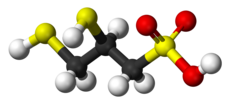| Revision as of 20:57, 26 August 2023 editWprlh (talk | contribs)Extended confirmed users21,401 edits Fixed typoTags: Mobile edit Mobile web edit← Previous edit | Latest revision as of 14:28, 12 January 2025 edit undoArthurfragoso (talk | contribs)Extended confirmed users, Template editors4,591 edits dark mode fix | ||
| Line 4: | Line 4: | ||
| | verifiedrevid = 477198497 | | verifiedrevid = 477198497 | ||
| | ImageFile = 2,3-Dimercapto-1-propanesulfonic acid.png | | ImageFile = 2,3-Dimercapto-1-propanesulfonic acid.png | ||
| | ImageClass = skin-invert-image | |||
| | ImageFile1 = DMPS-3D-balls.png | | ImageFile1 = DMPS-3D-balls.png | ||
| | ImageSize1 = 230px | | ImageSize1 = 230px | ||
Latest revision as of 14:28, 12 January 2025
 | |
 | |
| Names | |
|---|---|
| Preferred IUPAC name 2,3-Bis(sulfanyl)propane-1-sulfonic acid | |
| Other names 2,3-Dimercaptopropane-1-sulfonic acid | |
| Identifiers | |
| CAS Number | |
| 3D model (JSmol) | |
| ChEBI | |
| ChemSpider | |
| KEGG | |
| MeSH | Unithiol |
| PubChem CID | |
| UNII | |
| CompTox Dashboard (EPA) | |
InChI
| |
SMILES
| |
| Properties | |
| Chemical formula | C3H8O3S3 |
| Molar mass | 188.27 g·mol |
| Except where otherwise noted, data are given for materials in their standard state (at 25 °C , 100 kPa).
| |
2,3-Dimercapto-1-propanesulfonic acid (abbreviated DMPS) and its sodium salt (known as Unithiol) are chelating agents that form complexes with various heavy metals. They are related to dimercaprol, which is another chelating agent.
The synthesis of DMPS was first reported in 1956 by V. E. Petrunkin. The effects of DMPS on heavy metal poisoning, including with polonium-210, were investigated in the following years. DMPS was found to have some protective effect, prolonging the survival time.
A study was undertaken of DMPS use by workers involved in the production of a calomel skin bleaching lotion and in direct contact with mercurous chloride and that already showed elevated urine mercury levels. The sodium salt of DMPS was found to be effective in lowering the body burden of mercury and in decreasing the urinary mercury concentration to normal levels.
DMPS administered to a mercury poisoned animal model failed to remove the mercury from tissues and reduce the inorganic mercury burden in the brain, indicating it is not a useful intra-cellular chelation agent.
A 2008 study reported a case of Stevens–Johnson syndrome (SJS), a potentially serious disease, in a child undergoing chelation therapy with DMPS; the SJS resolved gradually after the chelation therapy was stopped.
A 2020 study found DMPS to provide some benefits taken orally in mitigating effects from hemotoxic snakebites (using venom from saw-scaled vipers Viperidae Echis) in mouse models when given soon after exposure, suggesting its potential for repurposing as a prehospital treatment.
See also
References
- Nomenclature of Organic Chemistry : IUPAC Recommendations and Preferred Names 2013 (Blue Book). Cambridge: The Royal Society of Chemistry. 2014. p. 697. doi:10.1039/9781849733069-FP001. ISBN 978-0-85404-182-4.
The prefixes 'mercapto' (–SH), and 'hydroseleno' or selenyl (–SeH), etc. are no longer recommended.
- Petrunkin, V. E. (1956). "Synthesis and properties of dimercapto derivatives of alkylsulfonic acids". Ukrainsky Khemichisky Zhurnal. 22: 603–607.
- Aposhian, H.V.; Aposhian, M.M. (1990). "Meso-2,3-dimercaptosuccinic acid: Chemical, pharmacological and toxicological properties of an orally effective metal chelating agent". Annual Review of Pharmacology and Toxicology. 30 (1): 279–306. doi:10.1146/annurev.pa.30.040190.001431. PMID 2160791.
- D. Gonzalez-Ramirez; M. Zuniga-Charles; A. Narro-Juarez; Y. Molina-Recio; K. M. Hurlbut; R. C. Dart; H. V. Aposhian (1 October 1998). "DMPS (2,3-Dimercaptopropane-1-sulfonate, Dimaval) Decreases the Body Burden of Mercury in Humans Exposed to Mercurous Chloride" (free full text). Journal of Pharmacology and Experimental Therapeutics. 287 (1): 8–12. PMID 9765315.
- Rooney, James (2007). "The role of thiols, dithiols, nutritional factors and interacting ligands in the toxicology of mercury". Toxicology. 234 (3): 145–156. doi:10.1016/j.tox.2007.02.016. PMID 17408840.
- Guzzi, GianPaolo; Caterina A.M. La Porta (2008). "Molecular mechanisms triggered by mercury". Toxicology. 244 (1): 1–12. doi:10.1016/j.tox.2007.11.002. PMID 18077077.
- Van der Linde AA, Pillen S, Gerrits GP, Bouwes Bavinck JN (2008). "Stevens–Johnson syndrome in a child with chronic mercury exposure and 2,3-dimercaptopropane-1-sulfonate (DMPS) therapy". Clin Toxicol. 46 (5): 479–81. doi:10.1080/15563650701779687. PMID 18568806.
| Chelating agents / chelation therapy (V03AC, others) | |
|---|---|
| Copper | |
| Iron | |
| Lead | |
| Thallium | |
| Other | |
| |